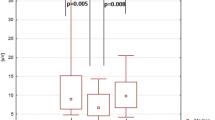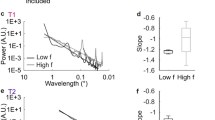Abstract
The conduction from the eye to the visual cortex through the brainstem was investigated in 43 cases of functional amblyopia by means of moving topography of short latency visual evoked potential (SVEP). Anomally of the SVEP such as a defect of the main component and remarkable reduction of amplitude was found in cases with severe amblyopia whose visual acuity was less than 0.5. The incidence of abnormal SVEP was recognized in 44% of anisometropic amblyopia (18 cases), 52% of strabismic amblyopia (15 cases), and 50% of deprivation amblyopia (10 cases). The results suggested a reduction of electric activity in the subcortical visual pathway including transmitting nuclei.
Similar content being viewed by others
References
Arden GB, Wooding SL (1985) Pattern ERG in amblyopia. Invest Ophthalmol Vis Sci 26: 88–96
Gottlob I, Welge-Lussen L (1987) Normal pattern electroretinogram in amblyopia. Invest Ophthalmol Vis Sci 28: 187–191
Hess RF, Baker CL, James N, Verhoeve JN, Keesey UT, France TD (1985) The pattern evoked electroretinogram: its variability in normal and its relationship to amblyopia. Invest Ophthalmol Vis Sci 26: 1610–1623
Ikeda H, Wrigh MJ (1974) Is amblyopia due to inappropriate stimulation of the “ sustained” pathway during development? Br J Ophthalmol 58: 165–174
Ikeda H, Wright MJ (1976) Properties of LGN cells in kittens reared with convergent squint: a neurophysiological demonstratin of amblyopia. Exp Brain Res 25: 63–77
Ikeda H, Treman KE (1979) Amblyopia occurs in retinal ganglion cells in cats reared with convergent squint without alternating fixation. Exp Brain Res 35: 559–582
Noorden GK von (1973) Histological studies of the visual system in monkeys with experimental amblyopia. Invest Opthalmol 12: 727–738
Noorden GK von, Middleditch PR (1975) Histology of the monkey lateral geniculate nucleus after unilateral lid closure and experimental strabismus: further observation. Invest Ophthalmol 14: 674–683
Noorden GK von, Crawford MLJ, Middleditch PR (1977) Effect of lid suture on retinal ganglion cells inMacaca mulatta. Brain Res 122: 437–444
Sokol S, Nadler D (1979) Simultaneous electro retino grams and visually evoked potentials from adult amblyopes in response to pattern stimulus. Invest Ophthalmol Vis Sci 18: 848–855
Tsutsui J, Kawashima S (1985) Dynamic topography of the human short latency visual evoked potentials. Neuroophthalmology 5: 155–160
Tsutsui J, Kawashima S (1986) Studies on short latency visual evoked potentials in cases with optic pathway lesicus. Neuroophthalmology 6: 247–255
Wanger P, Persson HE (1984) Oscillary potentials, flash and pattern-reversal electroretinograms in amblyopia. Acta Opthalmol 62: 643–650
Wiesel TN, Hubel DH (1963) Effects of visual deprivation on morphology and physiology of cells in cat's lateral geniculate body. J Neurophysiol 26: 978–993
Author information
Authors and Affiliations
Additional information
Dedicated to Dr. G.K. von Noorden on the occasion of his 60th birthday
Rights and permissions
About this article
Cite this article
Tsutsui, J., Kawashima, S. & Fukai, S. Short latency visual evoked potentials in functional amblyopia shown using moving topography. Graefe's Arch Clin Exp Ophthalmol 226, 301–303 (1988). https://doi.org/10.1007/BF02172954
Issue Date:
DOI: https://doi.org/10.1007/BF02172954




